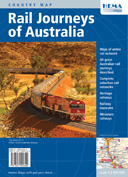The next step in the rejuvenation of Adelaide's tram system was marked with the opening of the second extension to the city's tram line in recent years. On Monday, trams commenced regular passenger services over the newly laid track from the former terminus at City West, west along North Terrace to West Terrace, then north-west along Port Road to the Adelaide Enterainment Centre.
Trams now operate at every 15 to 20 minutes throughout the day from the Entertainment centre, via North Terrace and King William Street in the city, through to Glenelg. Additional services operate on weekdays in the city area, and services are more frequent in peak hours.
Australian Rail Maps has updated our Adelaide train and tram map to include this newly opened route: http://www.railmaps.com.au/adelaide.htm
Adelaide's tramway history is both fascinating and tragic. For most of the early 20th century, Adelaide was blessed with a wonderful electric tram network. Services were extensive, frequent and reliable. Adelaide's terrain is ideally suited to trams - the roads are wide and the landscape flat. Not only that, the tramcars themselves were arguably the best built and most elegantly adorned of any in Australia. But alas, like so many other cities in Australia and around the world, Adelaide fell victim in the 1950s to the unfortunate and rapacious march of the motor car. From 1952 to 1958, one by one the city's tram routes were closed and relaced by what were portrayed at the time as more 'modern' motor buses or trolley buses. In truth though this was a blind for the move away from public to private (motorised) transport. By the end of 1958 only one single route remained - the largely off-road line from the city to Glenelg.
Whilst Adelaide was by no means alone in falling into this pit, it did have an added dimension. Many of Australia's most successful coachbuilders were based in Adelaide, and indeed these coachbuilders were the suppliers of quite a few of Australia's tramcars. Companies like Duncan and Fraser, Pengelly, Holdens and others, all based in Adelaide, built not only Adelaide's beautiful trams, but supplied tramcars to other cities across the nation. Unfortunately, after world war 2, these very companies learned that there was much more money to be made by building automobiles, and in one way or another they turned their back on trams and looked to the rubber wheeled vehicles. Thus began Adelaide's love affair with the car, and so was born the strength of the Adelaide based motor car building industry and the local political support for car usage and car construction industry. Ironically, Adelaide's prowess in tram building led to the political support for private transport.
Nonetheless, the Adelaide to Glenelg tramway survived after 1958, into the 1960s, 1970s, 1980s and on into the 1990s and 2000s. It did this without ANY new tramcars - it was operated solely by the original H class trams - built in 1929. Quite a remarkable feat that is a credit to Pengelly & Co the builders of those magnificent machines.
In the 1970s, there was so very nearly a tramway rejuvenation when there was a proposal to build a new tram line to the North-East - along what is known as the Modbury Corridor. However in such a tragically Adelaide fashion, at the very last minute, the tramway was cancelled by an incoming State government, and in its place an O-Bahn busway based on German technology was constructed. The O-Bahn still exists to this day.
In the mid 2000s, a slightly more enlightened air graced the environs of Adelaide as amid the worldwide return to public transport, local authorities realised that they had buried within their suburbs the kernel of a light rail system - the antique Glenelg tramway. So many light rail success stories were evident around the world - why not Adelaide? Well for a start, 80 year old tramcars was probably a limiting factor. So, for the first time in 50 years, an order for new tramcars was placed, and a brand new fleet of 21st century trams was brought to the old line. But that was only the start - why not extend the line? Well, in spite of much opposition, and claims that 'it doesn't go anywhere', the Glenelg tram line was extended in 2007 along Adelaide's two main thoroughfares, right through the heart of the city and past the main railway station to a new terminus at City West.
The return of trams to the heart of Adelaide's CBD was an immediate and enormous success. Patronage of course boomed. The politicians were emboldened, and soon a second extension was approved - from City West to the Entertainment Centre. This extension opened this week. A second order for more new tramcars has been placed, and an auxiliary fleet of loan tramcars has been pressed into service to cope with the traffic demand.
It's a great Cinderella story from which all advocates of public transport, in particular fixed rail public transport can take heart. The city that had turned its back on public transport and on trams, where its remaining tram service arguably continued to operate only through neglect rather than conscious action, has in its new generation so definitely embraced fixed rail street tramways.
Best wishes Adelaide. May this be just the first few steps towards a great 21st century tramway network that you so richly deserve and that will be a lasting memorial to the 20th century tramcar building industry that you gave us all.
Borderland, Part 3 (Point Pelee)
1 day ago



